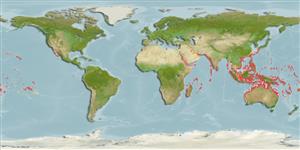Common names from other countries
分类 / Names
俗名 | 同种异名 | Catalog of Fishes(属, 种) | ITIS | CoL | WoRMS | Cloffa
Teleostei >
Eupercaria/misc (Various families in series Eupercaria)
鱸形目 (Various families in series Eupercaria) >
Labridae (Wrasses)
隆頭魚科 (Wrasses) > Corinae
Etymology: Cheilio: Greek, chanos, -eos, ous, and chasma, -atos = abyss, mouth opened, inmensity + Latin, muraena = morey eel (Ref. 45335).
More on author: Forsskål.
Environment: milieu / climate zone / depth range / distribution range
生态学
海洋 礁区鱼类; 深度上下限 1 - 30 m (Ref. 1602), usually 2 - 30 m (Ref. 27115). 热带; 24°C - 27°C (Ref. 27115); 32°N - 36°S, 24°E - 109°W
Indo-Pacific: Red Sea and East Africa to the Hawaiian and Easter islands, north to southern Japan, south to Lord Howe Island.
印度-太平洋: 红海而且东非到夏威夷与复活岛, 北至日本南部, 南至罗得豪岛。
大小 / 重量 / 年龄
Maturity: Lm ? range ? - ? cm
Max length : 50.0 cm SL 雄鱼/尚未辨别雌雄; (Ref. 9823); common length : 35.0 cm TL 雄鱼/尚未辨别雌雄; (Ref. 5450)
背棘 (总数) : 9; 背的软条 (总数) : 12 - 13; 臀棘: 3; 臀鳍软条: 11 - 12. Young individuals are usually a mottled brown or green, sometimes with a broad lateral stripe (Ref. 1602). Rare individuals may be uniformly yellow (Ref. 1602). Coloration in this fish is variable: green, brown, orange-brown or yellow, often with narrow, midlateral, broken black stripe which are absent in large males (Ref. 86689). Large males may develop a bright yellow, orange, black, white, or multicolored patch on their sides behind their pectoral fins (Ref. 1602).
幼鱼通常是褐色班点或者绿色, 有时有一条宽的侧面斑纹.(参考文献 1602) 稀有的个体可能是全身黄色的.(参考文献 1602) 大的雄性可能发育鲜黄色的,橘色的,和黑色的,白色, 或多色彩小区块在他们的身边上在胸鳍后面.(参考文献 1602)
Inhabit seagrass beds and algal-covered flats, occasionally in lagoon and seaward reefs to a depth of at least 30 m (Ref. 1602, 41878, 48636). Benthopelagic (Ref. 58302). Usually solitary. Juveniles secretive in seagrasses or attached Sargassum; adults usually in small loose aggregations, but occasionally form large schools to spawn (Ref. 48636). Feed mainly on crustaceans, mollusks, sea urchins (Ref. 37816) and other hard-shelled prey. Oviparous, distinct pairing during breeding (Ref. 205).
栖息于海草床与海藻覆盖的平台, 偶见于泻湖与临海礁石到深度至少 30 公尺.(参考文献 1602,48636) 通常独居性的。 稚鱼躲躲藏藏的在海草或附着的 马尾藻 中; 成鱼通常形成小的松散鱼群, 但是偶然地形成大群鱼群产卵.(参考文献 48636) 主要吃甲壳动物,软件动物,海胆 (参考文献 37816) 与其他的具有硬壳的猎物。
Life cycle and mating behavior
Maturities | 繁殖 | Spawnings | Egg(s) | Fecundities | 仔鱼
Oviparous, distinct pairing during breeding (Ref. 205).印度-太平洋: 红海而且东非到夏威夷与复活岛, 北至日本南部, 南至罗得豪岛。
Randall, J.E., G.R. Allen and R.C. Steene, 1990. Fishes of the Great Barrier Reef and Coral Sea. University of Hawaii Press, Honolulu, Hawaii. 506 p. (Ref. 2334)
CITES (Ref. 128078)
Not Evaluated
人类利用
渔业: 低经济; 水族馆: 商业性
工具
特别资料
下载 XML
网络资源
Estimates based on models
Preferred temperature (Ref.
115969): 24.4 - 29, mean 27.7 (based on 1206 cells).
Phylogenetic diversity index (Ref.
82804): PD
50 = 1.0000 [Uniqueness, from 0.5 = low to 2.0 = high].
Bayesian length-weight: a=0.00417 (0.00256 - 0.00679), b=3.09 (2.95 - 3.23), in cm Total Length, based on LWR estimates for this species & (Sub)family-body (Ref.
93245).
营养阶层 (Ref.
69278): 3.5 ±0.54 se; based on food items.
回复力 (Ref.
120179): 低的, 最小族群倍增时间4.5 - 14 年 (Preliminary K or Fecundity.).
Fishing Vulnerability (Ref.
59153): Moderate vulnerability (44 of 100).
